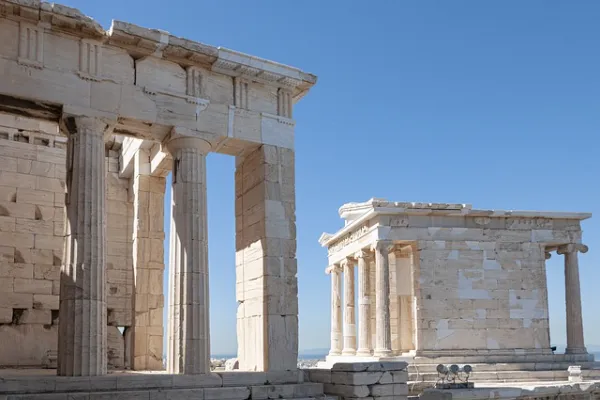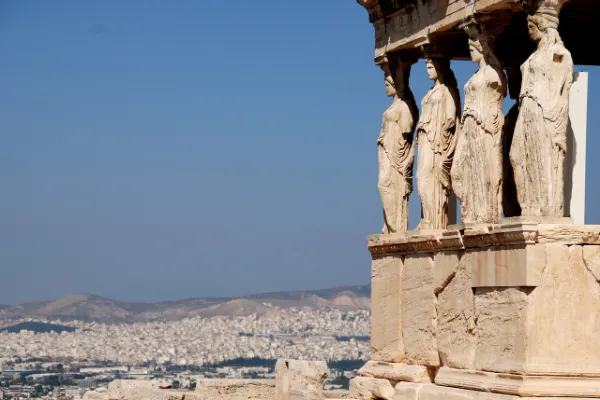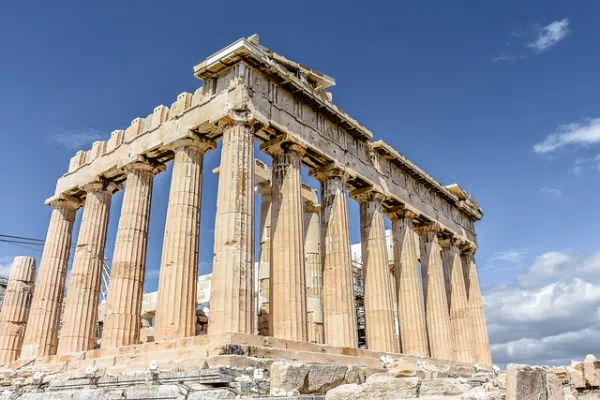Acropolis: More Than Just Facts

We present interesting facts about Acropolis. Let’s face it, Greece is crawling with ancient ruins. Temples stand around like forgotten birthday decorations, and every other field seems to have a pile of rocks that was “definitely something important” in 400 BC. But hold your togas, history buffs, because the Acropolis in Athens isn’t your average pile of rubble. This rocky outcrop is packed with interesting facts that make it way cooler than your grandma’s vacation slideshow.
Here are Some Interesting Facts About Acropolis:
Fact #1: Acropolis Actually Means “High City”

Shocker, right? This Greek word mashup of “akron” (highest point) and “polis” (city) basically translates to “uptown.” Makes sense, considering the Acropolis sits on a giant hunk of rock overlooking Athens. So next time you’re bragging about your rooftop apartment, just remember some folks were rocking the “acropolis life” thousands of years ago.
Fact #2: Not All Acropolises Are Created Equal
While the Athens Acropolis is the undisputed champion, there are acropolises scattered throughout Greece. Think of them as the budget versions – same concept, less fancy digs. Corinth has one, Rhodes has one, heck, there’s probably an acropolis in your grandma’s backyard if you dig deep enough (please don’t vandalize historical sites, grandma’s yard can wait).
Fact #3: The Acropolis Wasn’t Always Just Temples
Sure, the Parthenon is the star of the show, but the Acropolis once housed a whole bunch of other buildings. There was a gateway called the Propylaea, a temple dedicated to Athena Nike (the victory goddess, because duh), and even a spot for celebrating the Panathenaic Games, which was basically ancient Greece’s version of the Olympics, minus the synchronized swimming (thankfully).
Fact #4: The Parthenon Wasn’t Always White

Imagine your world in black and white – pretty dull, right? Well, that’s how the Parthenon would have looked to ancient Athenians. Thanks to fancy science stuff called “laser technology,” we now know the Parthenon was once a riot of color, with blues, reds, and greens adorning its sculptures and friezes. So next time you see a pristine white Parthenon picture, remember it’s basically airbrushed.
Fact #5: The Acropolis Has Seen Some Seriously Shady Stuff
The Acropolis has been through a lot in its 2,500-year history. It’s been a religious center, a military fortress, even a Christian church and a mosque (talk about a culture clash). It’s also been ransacked by a bunch of different empires, with many of its sculptures ending up who-knows-where (cough, cough, British Museum, cough).
Fact #6: The Acropolis Still Gets Damaged (Thanks, Tourists!)
Millions of tourists flock to the Acropolis every year, which is great for the Greek economy but not so great for the ancient buildings. All that foot traffic and pollution slowly wears down the structures. So, the next time you’re there, ditch the high heels and maybe lay off the souvenir selfie stick—ancient ruins deserve a little respect, even if they can’t complain yet. Keep reading for more Acropolis facts.
Fact #7: There’s Still Restoration Work Happening

The Acropolis isn’t just a museum; it’s a constant work in progress. Restoration efforts have been underway for over 40 years, with a focus on preserving the remaining structures and putting the puzzle pieces of history back together. So, don’t be surprised if you see scaffolding and cranes – it’s all part of keeping this ancient wonder standing tall.
Fact #8: The Acropolis Is a UNESCO World Heritage Site (Duh)
This shouldn’t come as a surprise. The Acropolis is a cultural and historical landmark of epic proportions. Earning a UNESCO World Heritage Site designation is basically the gold medal of historical importance.
Fact #9: You Can See the Acropolis From Space (Probably)
Okay, this one might be a stretch, but with all the fancy satellite imagery these days, there’s a good chance the Acropolis has been captured from space – a tiny speck of history on a big, blue marble. Pretty cool, huh?
Fact #10: The Acropolis Is More Than Just Rocks – It’s a Symbol of Greece
The Acropolis stands as a powerful symbol of Greece’s rich history and enduring spirit. It’s a reminder of the achievements of a bygone era and a testament to human creativity. Next time you see a picture of the Acropolis, remember that it’s not just a pile of rocks. We hope you enjoyed the interesting facts about Acropolis.
Fact #11: The Acropolis: A Historical and Cultural Treasure of Athens, Greece
Towering over Athens, Greece, the Acropolis is a potent symbol steeped in history and myth. This archaeological treasure trove isn’t just a collection of ancient buildings; it’s a window into Athenian culture, where every temple and monument whispers tales of gods and goddesses, artistic triumphs, and the birth of democracy.
Fact #12 Where Myths Live in Stone: The Acropolis Beckons Tourists and Storytellers
The Acropolis in Athens, Greece, is not just a majestic architectural feat, but also a mythological playground. Every structure whispers tales of Olympian gods and legendary heroes. It’s a gateway to a bygone era where gods and mortals coexisted.
Fact #13 A Constellation of Temples: Unveiling the Architectural Wonders of the Acropolis
The Acropolis in Athens, Greece, is an impressive architectural complex featuring the iconic Parthenon, the Erechtheion with its Caryatid maidens, the Temple of Athena Nike, and the Propylaea monumental gateway. Each structure is a testament to the enduring legacy of Athenian civilization.
Fact #14 Athens’ Golden Glory: The Acropolis as a Pinnacle of Art, Religion, and Games
The Acropolis in Athens, Greece was a symbol of artistic and religious achievement during the Golden Age. The Parthenon, its most prominent feature, housed a colossal gold and ivory statue of Athena, symbolizing Athenian power and piety. Every four years, the Panathenaic Games, a religious festival honoring Athena, culminated in a procession that ascended the steps of the Acropolis, further emphasizing its significance.
Fact #15 A Stone Symphony: Restoring the Artistic and Religious Tapestry of the Acropolis
The Acropolis in Athens, Greece, transcends the realm of mere stone and architecture. It stands as a powerful symbol of religious devotion and artistic mastery. Each temple, a testament to the ingenuity of Athenian sculptors and architects, was built to honor the Olympian gods. The towering Parthenon, with its intricate friezes depicting scenes from Greek mythology, served as a grand offering to Athena, the city’s patron goddess. However, time and the elements have taken their toll. Recognizing the Acropolis’s enduring significance, ongoing restoration and conservation efforts meticulously preserve this sacred site, ensuring that future generations can continue to witness the artistic brilliance intertwined with the deep religious beliefs of a bygone era.